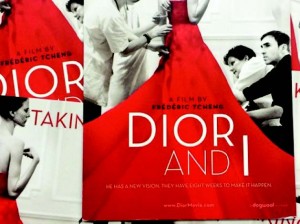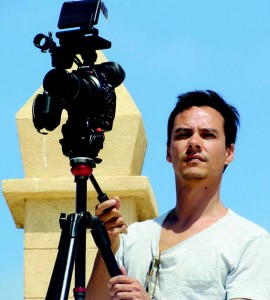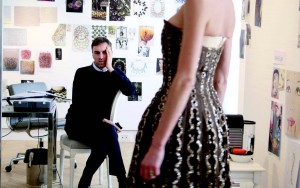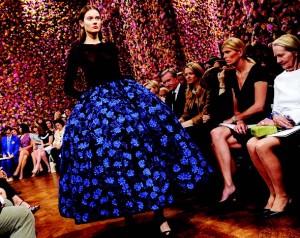 Dior and I is the third fabulous fashion documentary—after collaborating on Valentino: The Last Emperor and Diana Vreeland: The Eye Has to Travel—made by the openly gay Frédéric Tcheng. It is also the first he alone directed. This new film observes creative director Raf Simons in 2011 as he prepares his first haute couture show for the House of Dior. Simons creates designs, chooses fabrics, and gets to know his staff, whom he manages well. He also has setbacks, an exquisite if grandiose idea on how to stage the fashion show, and a severe case of nerves.
Dior and I is the third fabulous fashion documentary—after collaborating on Valentino: The Last Emperor and Diana Vreeland: The Eye Has to Travel—made by the openly gay Frédéric Tcheng. It is also the first he alone directed. This new film observes creative director Raf Simons in 2011 as he prepares his first haute couture show for the House of Dior. Simons creates designs, chooses fabrics, and gets to know his staff, whom he manages well. He also has setbacks, an exquisite if grandiose idea on how to stage the fashion show, and a severe case of nerves.
 Tcheng nimbly edits together the eight intense weeks of Simons and his staff preparing their show. He also seamlessly intercuts archival footage of Christian Dior to give a sense of the fashion house’s history as its future is unfolding.
Tcheng nimbly edits together the eight intense weeks of Simons and his staff preparing their show. He also seamlessly intercuts archival footage of Christian Dior to give a sense of the fashion house’s history as its future is unfolding.
The filmmaker recently spoke via Skype with me for the San Francisco Bay Times about making Dior and I.
Gary M. Kramer: This is your third fashion doc. Why do you have such an affinity for this world, and how did you come to make Dior and I?
Frédéric Tcheng: I think it’s just an opportunity, really. I am not particularly fashion oriented or coming from a fashion background. For me, the most important things are the story and the characters. I don’t go to fashion shows except to film. Olivier Biolobos, the head of communication and PR at Dior, fell in love with Diana Vreeland. I asked him about the future of Dior with John Galiano out. I told Olivier that, if it was going to be Raf, I wanted to document his arrival. Raf’s approach was very different, much more modern. His process was also like that of a painter; his references, and collaborations with his models, were totally refreshing. This film was a negative mirror of Valentino. What happens after the master steps down and the newcomer arrives when there is this strong sense of legacy?
 Gary M. Kramer: What can you say about filming the fashion shows that ends the film? The slow-motion runway was inspired. The models seemed to just float!
Gary M. Kramer: What can you say about filming the fashion shows that ends the film? The slow-motion runway was inspired. The models seemed to just float!
Frédéric Tcheng: That happened by chance. I’m very happy with how it turned out. Credit Léo Hinstin, who is the cinematographer for the runway segment. He has worked with fashion runways before. I said I didn’t want it to look like a typical runway. I wanted a slightly different look, and he came up with slow motion and the low angle that made them look sculptural. When I got the footage and played it the first time, I started crying [because] I was so moved by the lightness of the footage. I couldn’t have dreamt of a better set for the final runaway show. That was my MGM moment!
Gary M. Kramer: What surprised you in making the film?
Frédéric Tcheng: The level of emotion that Raf brought toward the end of the film. I was praying for that, but I didn’t expect it, knowing his personality and how modest he is. He didn’t like to flaunt his emotions. He’s very thoughtful, and generous and understanding of other people’s creative processes and that certainly applied to me. He later told me didn’t want to be too close during filming because he didn’t want to influence my decisions in the film.
Gary M. Kramer: Raf compares himself to Dior in the film. How are you like Dior? What qualities as a filmmaker do you share with the famous designer?
 Frédéric Tcheng: I identified with Raf most—maybe it was my personal journey as it was the biggest scale project and responsibility I have [taken on]. He had to deal with the legacy of Dior, but I had to deal with my subjects and honor them and find my own voice and do something uniquely mine. His creative struggles mirrored mine.
Frédéric Tcheng: I identified with Raf most—maybe it was my personal journey as it was the biggest scale project and responsibility I have [taken on]. He had to deal with the legacy of Dior, but I had to deal with my subjects and honor them and find my own voice and do something uniquely mine. His creative struggles mirrored mine.
Dior was a late bloomer. He worked for other people for a long time—several designers before he started his own line when he was 40. He had several careers, and he came from somewhat of an architectural background. I started as an engineer and got my degree in civil engineering (building). He was reserved, and that’s something I share with him and Raf does too. When I read Dior’s autobiography, he seemed totally genuine in the way he expressed himself. I liked his simplicity. He doesn’t seem self-conscious about how he comes across. I liked the humanity of Christian Dior and how he talked about his collaborators. You get a vivid sense of him and his team from his book. That’s why I decided to use the book in the film, and after I met Raf, it became obvious.
 There were so many parallels that the process had not changed in 50 years. It was a way of juxtaposing the past and the present the way Raf does with an archival jacket and pants. The two could cohabit and create something new. The voice of Christian Dior became a big part of it as I was researching, and as I was shooting, it became very clear, as a voice over. In editing, we started building the film around that.
There were so many parallels that the process had not changed in 50 years. It was a way of juxtaposing the past and the present the way Raf does with an archival jacket and pants. The two could cohabit and create something new. The voice of Christian Dior became a big part of it as I was researching, and as I was shooting, it became very clear, as a voice over. In editing, we started building the film around that.
© 2015 Gary M. Kramer
Gary M. Kramer is the author of “Independent Queer Cinema: Reviews and Interviews,” and the co-editor of “Directory of World Cinema: Argentina.” Follow him on Twitter @garymkramer
Recent Comments